
- Index
- Aspect Ratio
- Audio Inputs
- 3.5 Mm Jack (4)
- Audio L / R, Optical (3)
- Aux (20)
- Banana Jack (69)
- Bluetooth (3)
- Coaxial Digital (23)
- Component (11)
- Composite (4)
- Digital Coaxial Rca (79)
- Hdmi (152)
- Hdmi, Usb (25)
- Hdmi, Usb-c (3)
- Multiple (4)
- Optical, Audio L / R (5)
- Optical, Hdmi, Usb (5)
- Raw Cable Jack (12)
- Stereo L / R Rca (59)
- Usb (68)
- Usb-b, Aux (4)
- Wired (4)
- ... (2882)
- Bluetooth
- Brand
- Brightness
- Connectivity
- Bluetooth (131)
- Bluetooth / Wifi (78)
- Bluetooth / Wireless (24)
- Bluetooth, Hdmi (8)
- Bluetooth, Usb (17)
- Bluetooth, Wifi (8)
- Bluetooth, Wired (17)
- Bluetooth, Wireless (7)
- Hdmi (96)
- Hdmi Standard (31)
- Hdmi, Usb, Wired (8)
- Hdmi, Wired (18)
- Usb (9)
- Wired (624)
- Wired, Wireless (10)
- Wireless (130)
- Wireless / Wire (5)
- Wireless, Bluetooth (5)
- Wireless, Hdmi (5)
- Wireless, Wired (14)
- ... (2194)
Onkyo TX-NR818 AV Receiver 7.1 channel Home Theater HiFi Audiophile quality
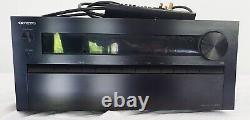
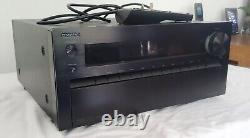
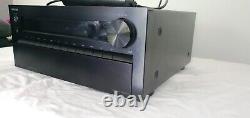

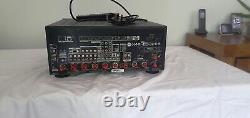



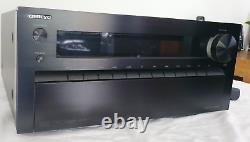

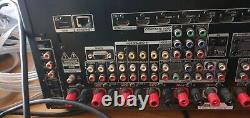
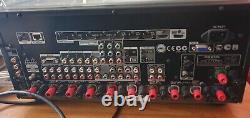


Onkyo TX-NR818 AV Receiver 7.1 channel Home Theater HiFi Audiophile quality. Absolute beast of an amplifier designed for cinema. If you want power and add dimension to listening to music this is brilliant aso has phono input. It weights 20 kg approx. Onkyo's TX-NR818 home theater receiver is an audio.
Its THX® Select2 PlusT badge of certification means it can reproduce riveting, accurate movie sound that'll have you glued to your TV screen. You also get the latest surround sound options, including Dolby® TrueHD and DTS-HDT Master Audio, two high-resolution formats found on many Blu-ray movies. The'NR818 uses Onkyo's WRAT (Wide Range Amplifier Technology) and a high-current power supply to deliver dynamic, punchy sound that stays clean even at higher volume levels.Amazing video quality is at the. The'NR818 boasts two fantastic video processors that work together to deliver superlative images.
The HQV® VidaT circuit upscales analog content to 1080p. And the Marvell QdeoT chip adds a crisp finish to the signal. Eight HDMI inputs - including one in front for easy access - let you connect. Plus there's ISF (Imaging Science Foundation) video calibration to dramatically improve picture quality. Each video input source is independently calibrated to achieve the best possible performance from your connected HDTV. And let's not forget that there are two HDMI outputs to connect to your TV. But movies, video games and TV are just the beginning. Just plug your iPod® into the front-panel USB port to get the beat started. This connection delivers a digital signal directly to the'NR818's superior processor so your music sounds awesome. Use the Ethernet port or the optional Onkyo Onkyo UWF-1 Wi-Fi adapter to connect the'NR818 to your broadband home network and you'll get easy access to the music files stored on your networked computers. Then dive into thousands of Internet radio stations - so you can enjoy entertainment from every corner of the planet. Your potential playlist just expanded exponentially.What would you like to do with seven channels? Most home theater setups are 5.1-channel, but the 7.2-channel TX-NR818 offers ways to experience even greater wraparound realism.
You can drive a pair of back surround speakers placed in the rear of your room to create greater spatial accuracy: get ready to duck when a mortar round screams overhead and explodes behind you. Or use those channels for "height" speakers, so when the incoming rounds start to fall, you may want to take cover. If your front speakers have dual sets of connectors, you can re-assign these two channels and "bi-amp" the speakers - doubling the power they receive is a great way to get every last ounce of performance from them. Or there's always the convenience of using those surround channels to play music on the deck speakers while the kids continue uninterrupted gaming in the theater room. The'NR818 comes equipped with Audyssey® sound-shaping tools to automatically balance and equalize the sound based on your room's acoustics.
Audyssey Dynamic Volume maintains optimum dynamics, so gone are the commercial sponsor's surprise sonic attacks. Onkyo's InstaPrevueT system lets you see thumbnails of digital video sources on-screen, taking out the guesswork of which HDMI source is plugged into what port. You also get a graphic user interface to make control easy and intuitive with overlays on your TV screen.
And you can download a free app to use your iPhone® and AndroidT devices as powerful Wi-Fi® system remotes. 135 watts per channel into 8 ohms (20-20,000 Hz) at 0.08% THD, with 2 channels driven. THX® Select2 PlusT certification guarantees pristine home theater sound. Dolby® TrueHD, DTS-HDT Master Audio, Dolby® Digital Plus, DTS-HDT High Resolution Audio and Dolby Pro Logic® IIz. Audyssey DSX® processing for enhanced surround sound height or width effects using additional front speakers.Dual core analog-to-HDMI video upconversion (up to 1080p) with HQV® Vida3and Marvell QdeoT video processing. ISF (Imaging Science Foundation) video calibration for each video source (calibration requires an ISF-certified technician). Audyssey MultEQ® XT32 eight-point auto setup and room calibration system (microphone included).
Audyssey Dynamic VolumeT mode to maintain steady listening levels. Audyssey Dynamic EQT for fuller surround sound at lower volumes. Direct digital connection of iPod®/iPhone® through front-panel USB input allows music control via receiver's remote. DLNA (Digital Living Network Alliance) certified to ensure optimal compatibility with other network-enabled equipment. Wi-Fi ready, requires optional Onkyo UWF-1 adapter.
Bluetooth integration requires optional optional Onkyo adapter. Powered audio output for 2nd or 3rd room (using powered 2nd room stereo output allows 5.1 home theater in main room).
Line-level stereo audio output for 2nd and 3rd room. 192kHz/24-bit Burr-Brown digital-to-analog converters for all channels. Pure Audio mode switches off unnecessary circuitry to provide cleaner sound. Back surround speaker channels re-assignable for bi-amping compatible front left and right speakers. Music Optimizer function enhances the sound quality of compressed music files.
1080p-compatible HDMI switching: 8 in (including 1 front-panel input), 2 out. HDMI version 1.4 with support for 3D video, Audio Return Channel, Deep Color, x. Color, auto lip-sync, and HDMI-CEC. Audio Return Channel function receives digital audio signals from a compatible HDTV's tuner via HDMI. Digital audio inputs: 2 optical and 3 coaxial. 5 inputs with composite video (1 front-panel). Component video switching with 2 inputs, 1 output.3 audio-only inputs, including a phono input for hooking up a turntable. Ethernet port for music streaming from a PC network. Preamp outputs for 2 powered subwoofers.
1 pair of main speaker outputs. Convenient on-screen display (via HDMI only).
Onkyo's free remote app lets you use your iPod touch®, iPhone® or AndroidT device as a Wi-Fi remote. 17-1/8"W x 7-13/16"H x 18-1/4D. Playback from Digital Audio Inputs. DTS, ES, HD, HDMA, Neo6, NeoX. ALLM (Auto Low Latency Mode).HDR (High Dynamic Range) Support. The Onkyo TX-NR818 replaces these items. The Onkyo TX-NR818 features a 7-channel amplifier rated at 135 watts (into 8-ohms, at 20Hz-20kHz, with 0.08%, driving 2 channels) and two mono subwoofer preamp outputs. The 7-channel amplifier can be configured in four ways.
The Onkyo TX-NR818 provides 7.2ch surround in your main listening area. You can listen to either surround back, front high, or front wide speakers.
The Front High/Zone 3 speaker terminals can be reassigned and used along with the Front terminals to bi-amp the front speakers, providing improved bass & treble performance. When bi-amping the front speakers, the receiver is limited to a 5.2ch speaker system in the main room and you cannot power additional speakers in Zone 2 or 3. The Front Wide/Zone 2 speaker terminals can be reassigned to power a pair of speakers in Zone 2. This configuration restricts the main listening room to 5.2ch surround (no surround back or Front High/Wide speakers). The Front High/Zone 3 speaker terminals can also be reassigned to power a pair of speakers in Zone 3. This configuration restricts the main listening room to 3.2ch surround (no surround/surround back or Front High/Wide speakers). WRAT (Wide Range Amplifier Technology). WRAT is based around a low negative-feedback circuit topology that works to reduce signal noise and distortion across the frequency range. A "closed ground-loop circuit" design is employed, in which each circuit has a separate link to the power supply. This helps to cancel individual circuit noise and keep the ground potential free of distortion. High Instantaneous Current Capability (HICC) enables WRAT amplifiers to immediately cancel the speakers' reflex energy and instantaneously send out the next signal. The same high current better manages speaker impedance fluctuations, which can negatively affect performance. Under the anti-resonant cover of any Onkyo receiver, you'll instantly notice the High Current Power Supply H. With its huge, isolated power supply design and high-capacity filter capacitors, it delivers the large amounts of power necessary for reproducing the wide dynamics of movie soundtracks and the detail and clarity of your music. Optimum Gain Volume Control adjusts the gain so that less than half the amount of attenuation is needed, ensuring the signal never comes close to the noise floor. This protects the signal against noise, resulting in a dramatically clearer sound. PLL jitter-cleaning circuit technology reduces jitter by comparing the input and output phases of the digital signal and creating an accurate clock waveform. This enhances the precision of digital signal processing and noticeably improves audio quality. Jitter-cleaning technology works both for digital signals input via HDMI and for digital signals converted from analog signals inside the receiver itself. This receiver is equipped with 192kHz/24-bit Burr-Brown DACs to decode and playback high-resolution recordings with less jitter and clearer sound. The Onkyo TX-NR818 is equipped with a powerful and highly accurate 32-bit processing DSP (Digital Signal Processor) for better surround sound reproduction. The Onkyo TX-NR818 AV receiver supports the following multi-channel (Dolby Digital, DTS, Dolby Pro Logic) decoding formats.Dolby Digital and DTS listening modes can only be selected if your audio source is connected to the AV receiver via a digital audio connection (HDMI, optical, or coaxial). To enjoy true 7.1ch Dolby Digital TrueHD and DTS-HD surround sound, the receiver must be connected to your Blu-ray player via HDMI. The TX-NR818 AV receiver is THX. Founded by George Lucas, THX develops stringent standards that ensure movies are reproduced in movie theaters and home theaters just as the director intended. From early design concepts to product rollout, THX works with its manufacturing partners at each step of product development.
Every detail is meticulously mapped to the THX performance standards. And THX engineers spend countless hours testing and analyzing each product for sound quality, usability and interoperability. The result of this collaborative process is a THX Certified receiver, amplifier or pre-amplifier designed from the ground-up to present your favorite movies, music, and games in 5.1ch to 7.1ch surround sound loud and clear at studio reference volumes.
THX Modes (Cinema, Music, or Game) carefully optimize the tonal and spatial characteristics of the soundtrack for reproduction in the home-theater environment. They can be used with various multichannel sources. Surround back speaker output depends on the source material and the selected listening mode. THX Ultra2+ (w/ THX Loudness Plus). The ultimate benchmark for home audio performance, THX Ultra2 Plus is specified for rooms where the screen-to-seat viewing distance is more than 12 feet and the room volume is 3,000 cubic feet or greater.
This mode expands 5.1-channel sources for 7.1- channel playback. It does this by analyzing the composition of the surround source, optimizing the ambient and directional sounds to produce the surround back channel output. You can choose between Cinema, Music, or Game mode. THX Loudness Plus is a volume control technology featured in THX Ultra2+ certified components. With THX Loudness Plus, home theater audiences can experience the rich details in a surround mix at any volume level. THX Loudness Plus compensates for the tonal and spatial shifts that occur when the volume is reduced by intelligently adjusting ambient surround channel levels and frequency response. The THX Loudness Plus feature can be applied when listening in any THX listening mode. This mode expands 5.1-channel sources for 6.1/7.1- channel playback.It's especially suited to Dolby Digital EX sources. THX Surround EX, also known as Dolby Digital Surround EX, is a joint development between Dolby Laboratories and THX Ltd. Onkyo's Original DSP Modes, combined with Dolby Digital/DTS/Dolby Pro Logic processing, produce more realistic, powerful sound effects for your movie and music sound tracks based on the type of content and your home theater setup.
You can choose from the following. For classical or operatic music.
For acoustic instruments, vocals, and jazz. Suitable for rock or pop. Adds realistic acoustics to TV shows. The receiver offers four different Gaming modes - RPG, Action, Rock, and Sports.Stereo sound from all speakers. All speakers output the same sound in mono. Theater-Dimensional circuitry takes the complexity out of conventional surround-sound setups and lets you experience the excitement of surround sound from as few as two ordinary speakers. Theater-Dimensional's unique multi-speaker modes let you place up to five speakers conveniently by the TV, for the most realistic virtual-surround sound possible. The Onkyo TX-NR818 offers two audiophile listening modes which bypass the receiver's tone & DSP processing for higher sound quality performance.
In Direct mode, audio from the input source is output without surround-sound processing. This mode delivers pure sound with minimum sound quality adjustment and filtration.
In Pure Audio mode, the display and video circuitry are turned off, minimizing possible noise sources for the ultimate in high-fidelity audio reproduction. The TXN-R818 features a full package of Audyssey audio technologies for optimal sound quality. Audyssey Dynamic Volume offers real-time volume adjustment, while Audyssey DynamicEQ improves your system's surround effects during low volume levels. Audyssey MultEQ XT32 automatically sets speakers to suit your room's listening environment and the speakers' characteristics. The AV receiver even offers Audyssey DSX which adds front speaker effects. Audyssey MultEQ XT32 Automatic Speaker Setup. With the supplied speaker setup microphone, Audyssey MultEQ XT32 determines the number of speakers connected, their optimum crossover frequencies, and their distances from the primary listening position, then adjusts each automatically. The room's acoustical properties are then measured and corrected over the listening area in both the frequency and time domain. There is a threaded insert on the bottom of the microphone so it can be mounted on a tripod for accurate listening position placement. Up to 8 listening position measurements are taken to optimize the surround effect for a broad area. If you prefer you can also setup your speaker system manually. Audyssey Dynamic EQ solves the problem of deteriorating sound quality as volume is decreased by taking into account human perception and room acoustics.Dynamic EQ selects the best possible frequency response and surround levels moment-by-moment as volume is changed. The result is bass response, tonal balance and surround impression that remain constant despite changes in volume. Audyssey Dynamic EQ combines information from incoming source levels with actual output sound levels in the room, a prerequisite for delivering a loudness correction solution.
Audyssey Dynamic EQ works in tandem with Audyssey 2EQ to provide well-balanced sound for every listener at any volume level. Audyssey Dynamic Volume solves the problem of large variations in volume level between television programs, commercials, and between the soft and loud passages of movies. Dynamic Volume looks at the preferred volume setting by t he user and then monitors how the volume of program material is being perceived by listeners in real time to decide whether an adjustment is needed. Whenever necessary, Dynamic Volume makes the necessary rapid or gradual adjustments to maintain the desired playback volume level while optimizing the dynamic range. Audyssey Dynamic EQ is integrated in Dynamic Volume so that as the playback volume is adjusted automatically, the perceived bass response, tonal balance, surround impression, and dialog clarity remain the same whether watching movies, flipping between television channels, or changing from stereo to surround sound content.Audyssey Dynamic Surround Expansion (DSX). Audyssey DSX adds front effect speakers to improve spatial sound reproduction. Starting with a 5.1 channel system, DSX adds front Wide and/or front Height channels for better sound staging (although both wide and height speakers can be added, only one pair is used at a time). DSX also applies Surround Envelopment Processing to enhance the blend between the front and surround channels. The Onkyo TX-NR818 lets you tweak and fine tune specific surround sound modes to suit your preference.
Dolby Pro Logic II Music Settings. While listening in the Dolby Pro Logic II Music format, there are three further enhancements you can adjust; Panorama: (broadens the front stereo image to the surround speakers to provide a wraparound effect), Dimension (allows you to move the sound field forward or backward), and Center Width (allows you to adjust the width of the center channel). Pro Logic IIz Height Gain. The Height Gain Control in Dolby Pro Logic IIz enables the listener to select how much gain is applied to the front high speakers. There are three settings, "Low", "Mid" and "High", and the front high speakers are accentuated in that order.While "Mid" is the default listening setting, the listener may adjust the Height Gain Control to their personal preference. In the Neo:6 Music mode, the Center Image feature adjusts the output of the left and right channels relative to the center channel, allowing you to make the center channel more or less dominant as needed. This improves the image of the center channel, especially when the listener is off-center. Adjustment varies from 5 (nothing subtracted from the L/R channels) to 0 (L/R channel output is cut in half).
By using the front high speakers, this function moves the center image of the dialogue upwards, so that the image of dialogue is fixed to the display height. While listening in the Theater Dimensional mode you can adjust the listening angle to either Wide (if listening angle is 40°) or Narrow (if listening angle is 20°).
THX Loudness Plus is a volume control technology featured in THX Ultra2 Plus certified receivers. Dolby Volume automatically adjusts the difference in volume levels which can occur between different contents or source components, freeing the user from having to make volume adjustments. Also, by adjusting the frequency balance according to the playback volume, it recreates the original source audio.
Dolby Volume therefore provides comfortable listening, effectively controlling the volume level difference without unnatural changes in volume or sound quality to recreate the balance and nuance of the source audio. Dialog Normalization (DialogNorm) is a feature of Dolby Digital, which is used to keep the programs at the same average listening level so the user does not have to change the volume control between Dolby Digital, Dolby Digital Plus, and Dolby TrueHD programs.
Using the CinemaFilter you soften overly bright movie soundtracks. Movie soundtracks are typically mixed for a large theater (relative to your home theater) with lots of soft seats and thick curtains on the walls. Home theater settings often lack these high frequency absorbing wall treatments, making the soundtrack sound too bright. CinemaFilter accounts for this and for many movies sounds more natural at home.
While MP3 or AAC files may sound fine through the headphones of your portable digital player, the limitations of these files can be exposed when played back through a quality home entertainment system. This is because a significant amount of high-frequency bit information is lost during the file-compression process. To counter this, Onkyo has designed the Advanced Music Optimizer to compensate for lost bit information and improve the quality of compressed audio signals. This results in a clearer and more expansive sound. Also included in this technology is a loudness correction feature that further improves the audio character of compressed files.
The Music Optimizer function only works with PCM digital audio input signals with a sampling rate below 48kHz and analog input signals. With the Re-EQ function, you can compensate for harsh high-frequency content, making it more suitable for listening. The Late Night feature limits the dynamic range of Dolby Digital recordings. Limiting the dynamic range makes it easier to find a volume that ensures the quiet sounds are not too quiet and the loud sounds are not too loud for night time listening. This allows you to comfortably listen to without the need to constantly adjust the volume to keep from waking family/neighbors.
The choices are: Off, Low, and High. This feature only works with Dolby Digital Encoded software and the depth of the feature will vary based on the individual software package. You can independently adjust the Bass (50Hz) and Treble (20kHz) of the TX-NR818 from -10 to +10 dB. The Onkyo AV receiver provides the following volume settings. With IntelliVolume, you can set the input level for each input (+/-12dB) selector individually.
This is useful if one of your source components is louder or quieter than the others. This function does not work in Zone 2. Use this feature to set the receiver's maximum volume level. This feature is useful to avoid turning the volume too loud by mistake.
You can set the Max Volume from 30-79 (max), or Off (disabled). Use this feature to set the volume level when the power is turned on. You can choose between Last (same as the volume when the unit was turned off), Min (0), or 1-78. With this setting, you can specify the headphone volume (+/-12dB) relative to the main volume. This is useful if there's a volume difference between your speakers and your headphones. The Onkyo AV receiver offers a variety of analog and digital audio inputs/outputs. The Onkyo receiver is equipped with three optical digital inputs (2 rear/1 front) and three coaxial digital inputs. All four digital inputs are assignable. You can choose auto decoding, PCM, or DTS for the digital audio inputs.Auto will decode the signal in its original form (Dolby Digital, DTS, PCM, etc), PCM decodes the signal to 2-channel, while DTS decodes only DTS formatted sources. The Onkyo TX-NR818 features 7.2ch pre-amp outputs (Front, Center, Surround, Surround Back/Front Height/Front Wide, and dual subwoofer) for connection of an external power amplifier. The Onkyo TX-NR818 is equipped with color-coded binding-post terminals for all speaker connections; including Front L/R, Center, Surround L/R, Surround Back L/R, Front Wide/Zone 2 (L/R), and Front High/Zone 3 (L/R).
The binding post terminals will accept bare-wire, pin-connectors, and banana plugs (single/dual). The Onkyo A/V receiver is fitted with a Phono input and ground terminal for connection of a turntable (MM). When headphones are plugged into the full-size 1/4 jack on the front panel, all the speakers are automatically muted. When you connect an iPod or iPhone to the USB port on this receiver, no sound will be output from the headphone jack. The Onkyo TX-NR818 employs a dual core video engine with HQV Vida and Marvel Qdeo processing for exceptional reproduction of standard and high definition video sources.
HQV Vida Video Processor (VHD1900). The TX-NR818 is equipped with the sophisticated HQV Vida VHD1900 processor to enhance the quality of both standard-definition and high-definition video sources. The chip employs multi-cadence tracking, expanded 12-bit color processing, and four-field motion-adaptive de-interlacing to optimize video quality and detail. Two new HQV technologies are incorporated into the VHD1900: "Auto HQV" works to automatically enhance the incoming image, while "HQV StreamClean" cleans up compressed video in real time by eliminating mosquito and block noise from lower-quality sources such as online video sites. Marvel Qdeo Video Chip for 4K Upscaling.
The Onkyo TX-NR818 utilizes a Marvel Qdeo Video Chip for 4K Upscaling and video processing. The Marvel Qdeo Video Chip produces quiet and natural video, free from noise and artifacts. Analog video signals (composite/component) are converted to HDMI and can be scaled to the resolution set in the menu: Through (no scaling), Auto (automatically scaled to the highest resolution supported by the display), 480p, 720p, 1080i, 1080p, or 4K. The TX-NR818 has eight HDMI v1.4 inputs (7 rear/1 front). The front jack is fixed as the Aux input, while the six rear panel jacks are assignable to any of the other inputs.
There are two HDMI monitor outputs; both outputs can be active simultaneously and will pass digital audio and video. The HDMI inputs will support uncompressed standard or high definition digital video along with the following audio signals: 2-channel linear PCM, Multichannel linear PCM, and Bitstream. The receiver's HDMI circuitry allows the receiver to output an HDMI audio signal from its speaker outputs, headphone out, and HDMI out so you don't have to run additional analog or digital cables. The HDMI inputs accept 480i, 480p, 720p, 1080i, and 1080p video signals. The analog video inputs (composite/component) are converted to HDMI for transfer to the TV.The 2 HDMI outputs display the same video signal and can be used simultaneously. The front-panel HDMI port is designed for the connection of select mobile phones and other portable electronic devices using the new MHL standard. MHL allows you to display full 1080p video and still images on your HDTV with up to 7.1 channels of surround sound.
By programming the A/V receiver's supplied remote control with the appropriate numeric code, you can use it to operate your connected MHL-enabled smartphone. Your connected smartphone is also recharged upon connection, and no separate power supply for the device is necessary while connected to the receiver. The A/V receiver is compatible with Android smartphones from Samsung, HTC, and LG (must support MHL standard); as of 6/7/2012. The TX-NR818's HDMI v.1.4 connections will accept 3D video from your 3D-ready Blu-ray player and output the video signal in 3D to your 3D-ready flat-panel television. The AV receiver supports x. Color, offering a wider color range than the current broadcast standard.
Color feature to be useful, the entire video production chain must be compatible (camera-editing-format-player-display). The Onkyo receiver also supports Deep Color which allows the color depth of video signals passing through HDMI to be raised. The number of colors that could be expressed by 1 pixel was 24 bits (16,777,216 colors) with a standard HDMI jack.
However, the number of colors which can be expressed by 1 pixel is 36 bits with a Deep Color enabled HDMI jack. Since the gradation of the depth of a color can be expressed more finely with more bits, continuous color changes can be more smoothly expressed. For the Deep Color feature to be useful, the entire video production chain must be compatible (camera-editing-format-player-display). When enabling the HDMI Through function, regardless of whether the AV receiver is "on" or in "standby" both audio and video streams from an HDMI input will be output to your television, via the receiver HDMI monitor output. You can select between 3 HDMI Through functions modes. Detects the signal and automatically selects the input sources. Selects the input source (BD/DVD, VCR/DVR, CBL/SAT, Game, PC, Aux, TV/CD, Port) for which the HDMI Through function in enabled. The HDMI Through function is activated on the input source selected at the time of setting the AV receiver to the "standby" mode. This feature allows audio to be sent from your compatible HDTV to your receiver through the same HDMI cable already being used to send audio and video to your HDTV. This eliminates the need for extra cables connected to your television. The receiver's main HDMI monitor output supports the ARC function, while the sub HDMI monitor output does not. InstaPrevue technology provides a live video thumbnail of the available content on your devices connected to the receiver via HDMI. As a result, you can preview audio/video streams coming from up to 5 HDMI inputs previously assigned to input selectors on your HDMI connected TV. Even with multiple components connected to receiver through HDMI, you can easily switch between inputs as their previews are displayed on a single screen on your television. You can even use the InstaPrevue feature for Picture-in-Picture.You can specify the number of preview thumbnails, as well as their positioning on-screen. If no video signal are present, the thumbnails will be filled in black. With 3D video signals, the image may not be properly rendered on the preview thumbnails of InstaPrevue.
The Lip Sync function can automatically synchronize HDMI audio and video that has gotten out of sync due to the complex digital video processing being performed by your HDMI-compatible TV. With HDMI Lip Sync, the audio delay required to synchronize the audio and video is calculated and applied automatically by the AV receiver. Occasionally, you may need to manually adjust the audio/video signals that are not properly synchronized manually. Typically when using a progressive scanning DVD player. You can correct this by delaying the audio; options are 0 (no delay) to 800 milliseconds, in 10 millisecond steps.
The receiver features a front-panel AV input for easily connecting a portable device; there are stereo RCA, composite video, optical digital, and HDMI jacks. Using the Picture Adjust feature, you can adjust the picture quality and reduce any noise appearing on your TV screen. Auto, Full, Zoom, Wide Zoom, or 4:3.
Custom (all settings can be performed manually), ISF (Day/Night), Cinema (for movies), Game (for gaming), Streaming (reduces mosquito/block noise), Through (changes resolution), Direct (no adjustment). You can change the following settings to be suitable for your movie or game screen.You can adjust Brightness (Red/Green/Blue), Contrast (Red/Green/Blue), Hue, Saturation, Color Temperature, and Gamma (RGB) of picture. If video signal delay occurs during playback on a video component i. Game console, select the corresponding input source and set the "Game Mode" setting to "On". The delay will decrease but in return the picture quality will become poor. Video (Film Mode detection is not applied and the input signal is handled as a video source) Auto detects whether the input signal is a video or a movie.
If it is a movie, the appropriate conversion is applied. With Edge Enhancement, you can make the picture appear sharper. With this setting, you can reduce noise appearing on the screen. With Mosquito Noise Reduction, you can remove the shimmering or haziness that sometimes appears around objects in the picture.
Mosquito noise can be an issue with overly compressed MPEG content. With Block Noise Reduction, you can remove the block distortion that sometimes appears in the picture. Block noise can be an issue with overly compressed MPEG content. ISF (Imaging Science Foundation) Video Calibration. The Onkyo TN-NR818 offers ISF (Imaging Science Foundation) video calibration for optimal video performance.
The receiver has been designed to incorporate setup and calibration standards established by the Imaging Science Foundation (ISF). The ISF has developed carefully crafted, industry-recognized standards for optimal video performance and has implemented a training program for technicians and installers to use these standards to obtain optimal picture quality from the receiver.Accordingly, Onkyo recommends that setup and calibration be performed by an ISF Certified installation technician. The Onkyo TX-NR818 A/V receiver is network-ready, which means you can connect it to your home network with a standard Ethernet cable and enjoy the music files stored on your computer or media server.
If your network is connected to the Internet (broadband), you can also enjoy Internet radio. Connecting the A/V receiver's Ethernet (RJ-45) port to a 100Base-TX switched Ethernet network is recommended for best results. Use a shielded CAT-5 Ethernet cable to connect the receiver to your home network. You can play back music files stored on your computer or media server (the TX-NR818 is DLNA certified).Compatible music file formats include MP3 (8-320 kbps), WMA (5-320 kbps), WMA Lossless (16/24-bit), WAV (8/16/24-bit), AAC (8-320 kbps), FLAC (8/16/24-bit), Ogg Vorbis (48-500 kbps), LPCM (8/16/24-bit), Apple Lossless (16/24-bit), DSD, and Dolby TrueHD. Each folder on the server may contain up to 20,000 music files, and folders may be nested up to 16 levels deep. The following media servers are compatible.
Windows Media Player 11 or 12. Windows Media Connect 2.0.
